Iron-rich products: for children, babies, during pregnancy [table].
Check out iron-rich products for adults, children and pregnant women.


Learn more about our editorial process
.

Learn more about our editorial process
.

Learn more about our editorial process
.

Learn more about our editorial process
.![Iron-rich products: for children, babies, during pregnancy [table].](https://cdn-resources.natu.care/uploads/1/best_nutritious_food_fight_with_anemia_containing_natural_iron_vitamins_minerals_1_ab912be56c.jpg)
Why you can trust us
Articles on Natu.Care are written based on scientific research, data from government websites and other reliable sources. The texts are written in cooperation with doctors, nutritionists and other health and beauty experts. Articles are reviewed before publication and during significant updates.
.Learn more about our editorial process
.Information about advertisements
Content on Natu.Care may contain links to products from the sale of which we may receive a commission. When creating content, we adhere to high editorial standards and take care to be objective about the products discussed. The presence of affiliate links is not dictated by our partners, and we select the products we review ourselves completely independently.
.Learn more about our terms and Conditions
.A deficiency of it affects more than 1.2 billion people (mostly women) worldwide. And it is one of the most important minerals in the human body - involved in the process of delivering oxygen to all corners of the body. It is an iron that is worth taking care of in your diet.
With clinical nutritionist Julia Skrajda, we will show you iron-rich products for adults, children, babies and also pregnant women. You are sure to find something you like, as iron is in many products available at your fingertips.
From this article you will learn:
- What products are rich in iron. .
- What is the difference between haem iron and non-haem iron. .
- How to increase iron bioavailability. .
- What limits iron absorption. .
- How much iron should be taken in each day. .
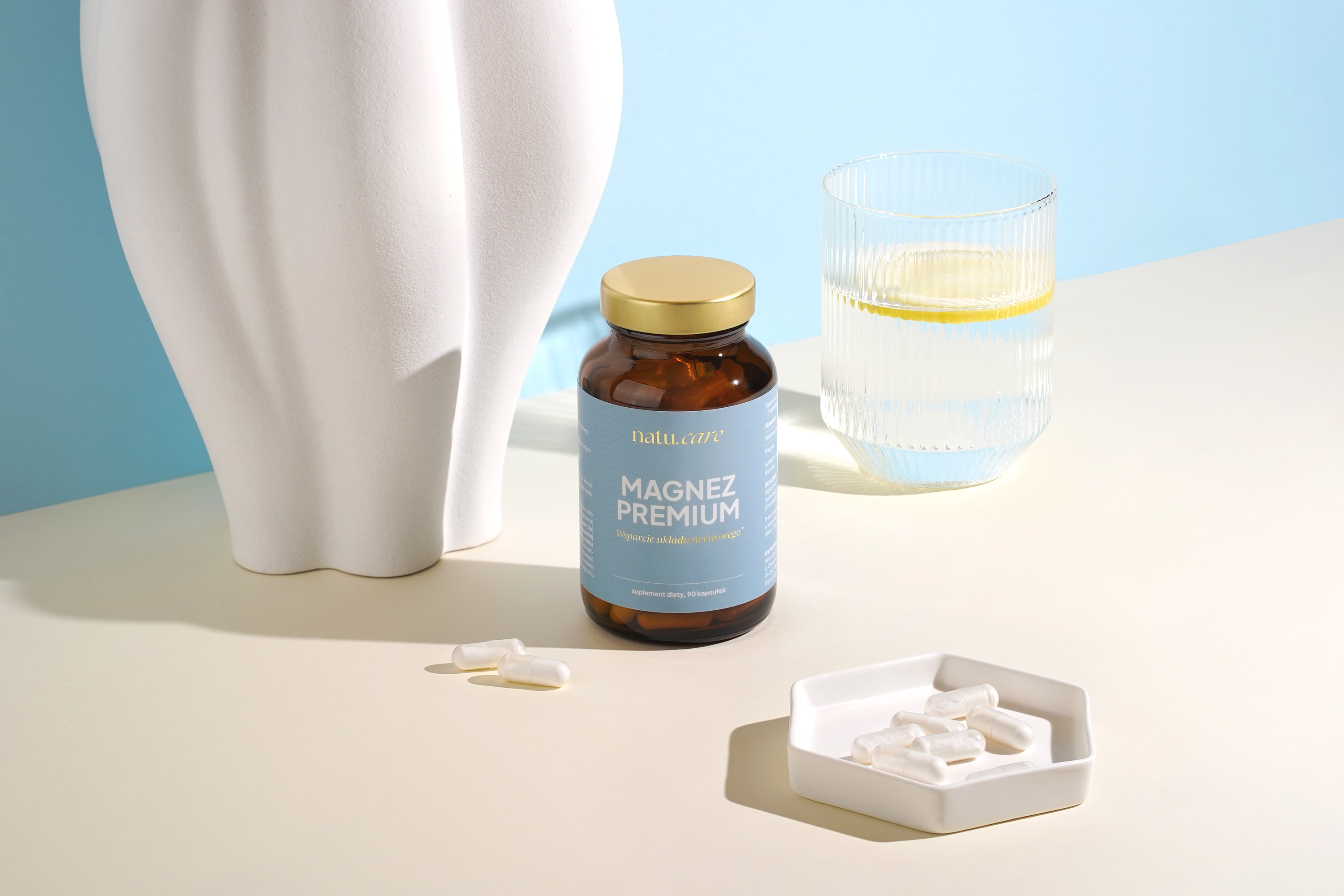
Sprawdź, co połączenie magnezu i witaminy B6 może zrobić dla Twojego zdrowia! -15% z kodem BLOG15
Natu.Care Magnez Premium + Witamina B6
Wesprzyj prawidłowe funkcjonowanie układu nerwowego, krwionośnego i mięśniowego dzięki synergicznemu działaniu magnezu i witaminy B6. Odkryj pełnię korzyści dla Twojego zdrowia każdego dnia!
Sprawdź cenę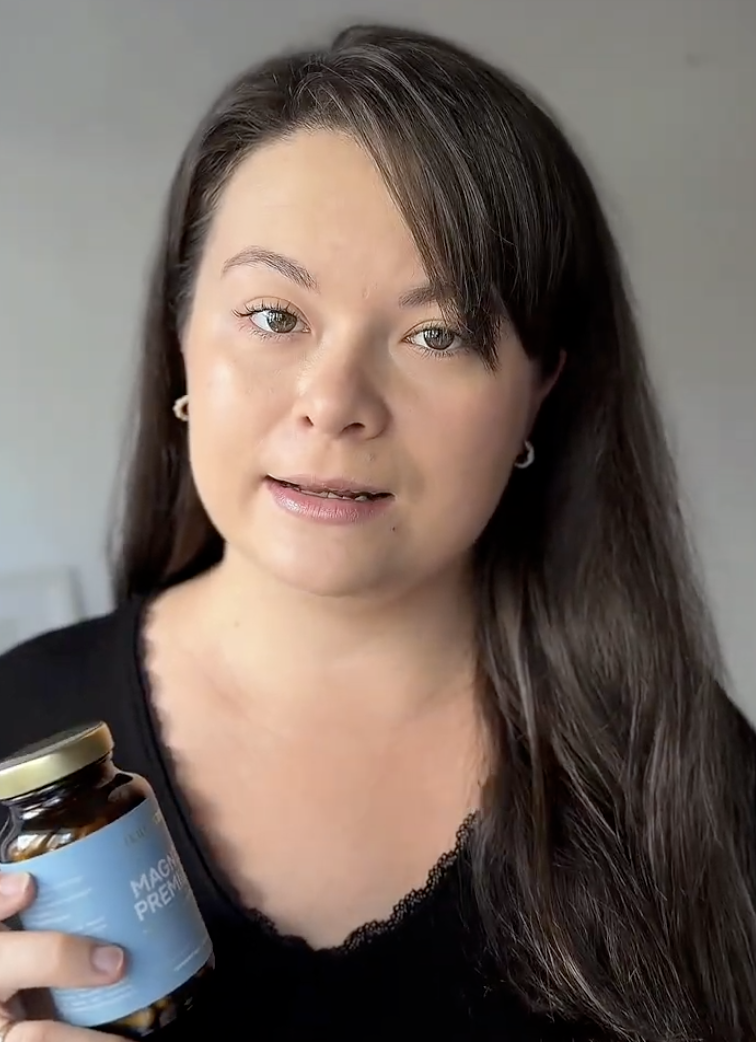
Magnez Premium przyjmuję już od 2 miesięcy i naprawdę czuję się znacznie lepiej. Mam więcej energii, przestałam mieć skurcze i nie denerwuję się już tak szybko, co w przypadku bycia mamą – bywa wyzwaniem!@DianaW.
See also:
- Best magnesium - ranking .
- Iron - action
- Potassium in the body
- Magnesium - properties .
- Copper - what it helps with .
- Iodine - when to take .
- Selenium - what it is .
- Zinc - properties
- Zinc tablets - what's the best one
- Chromium - applications
- MSM (organic sulphur) - what it is .
Iron-rich products
.
Products rich in iron include meat (e.g. poultry), fish (e.g. tuna), beans, peas, lentils, tofu, spinach, beetroot. Seeds (e.g. millet and buckwheat groats), oatmeal, tomatoes, pumpkin seeds will also provide you with iron. Iron-rich foods also include offal (e.g. liver) and legumesand.
Iron-rich foods - table
. .
|
Product . |
Iron content per 100 gand |
|
Bitter chocolate 85% . |
10.9 mg |
|
Poultry liver . |
8.99 mg . |
|
Pumpkin seeds |
8.82 mg |
|
Beef liver . |
6.54 mg . |
|
Oatmeal . |
3.90 mg |
|
Lentils |
3.33 mg |
|
Halves |
2.81 mg |
|
Beef . |
2.74 mg |
|
Spinach |
2.71 mg |
|
Dried apricots |
2.66 mg |
|
Tofu |
2.66 mg |
|
Rodins |
2.30 mg |
|
Green peas |
1.90 mg |
|
Hen's egg |
1.67 mg . |
What are the best sources of iron for babies and children?
.
Iron deficiency in young children is a common problem faced by many parents. Fortunately, it is relatively easy to enrich the diet of children with products rich in iron. This way, there is no need to reach for supplementation straight away.
The best iron-rich products for babies and children areand:
- Red meat (beef, pork). .
- Excrement (beef liver). .
- Poultry (chicken, turkey).
- Cereals (chicken, turkey).
- Cereal or oatmeal. .
- Pulses (beans, lentils). .
- Leafy vegetables (kale, broccoli, spinach). .
- Pumpkin seeds. .
- Risins. .
- Eggs. .
- Green peas. .
Your child is at the challenging stage? You can encourage them to eat these iron-rich foods by making sure the plate is colourful and various, as well as rich in different flavours (e.g. lightly spiced chicken with sauerkraut for a breakthrough) and structures, e.g. cream of pod soup with whole-grain croutons and roasted seeds.
See also:
.
Note
.For infants, the above foods should be introduced into the diet very carefully. For example, red meat is best started between 6 and 8 months of age, when the infant's need for iron increases. To be safe, meat should be cooked and cut into small pieces or blended. Similar rules apply to other foods, so it is worth consulting with a dietician or paediatrician.
What are the iron-rich foods for pregnant women?
.
To avoid iron deficiency during pregnancy, eat a variety of foods that are rich in iron, such as red meat (e.g. beef tenderloin), poultry, offal, legumes, leafy vegetables, mussels or tofu. It is also worth making sure to eat eggs, fish, as well as groats - millet or buckwheat.
Before starting iron supplementation during pregnancy, you should take a blood test. And the decision to add the supplement to your diet can only be made by your doctor..
 .
.
Witold Tomaszewskidoctor of medical sciences
.What is the difference between non-haem iron and haem iron?
.
Iron exists in two main forms: heme iron and non-heme iron, which differ in their origin and bioavailability to the body.
heme iron is the form of iron that you find mainly in animal products, especially meat, poultry and fish. It is characterised by its high bioavailability, as the human body is able to absorb up to 40% of this type of iron. Furthermore, the bioavailability of haem iron is not much affected by other dietary componentsand.
Non-heme iron on the other hand, is the form of iron found in plant foods like vegetables, fruits, legumes, nuts, seeds and whole grain cereal products.
The bioavailability of this type of iron is lower compared to haem iron. Furthermore, certain dietary components such as proteins may hinder its absorption. On average, the absorption of non-haem iron is around 10%. However, it is aided by eating foods that are rich in vitamin Cand.
What foods increase the bioavailability of non-haem iron?
.
You can increase the bioavailability of non-haem iron by eating the right products. Most of these are foods rich in vitamin C and those that naturally provide haem iron. What is worth eating?
- Oranges, .
- Strawberries, .
- kiwi, .
- grapefruit, .
- apricot, .
- broccoli, .
- red meat, .
- poultry, .
- fishes (mainly tuna), .
- pickled vegetables, .
- tofu, .
- spinach, .
You can increase your overall iron absorption with clever combinations of foods, such as liver served with sauerkraut; salad with spinach, pumpkin seeds, cranberries and chicken; sourdough bread with sausage, parsley and pickled cucumber. These are natural sources of iron and vitamin C, which will increase its bioavailability.
Note
Lactoferrin (a glycoprotein) is a popular dietary supplement that promotes iron absorption and increases serum iron, ferritin and haemoglobin concentrations.
What interferes with iron absorption?
.
To ensure the best possible absorption of iron from food, you should avoid combining it with certain ingredients. Certain substances reduce the bioavailability of non-haem iron from meals, that is, they cause it not to be absorbed into the bloodstream in a sufficiently large amountand.
Do not eat iron-rich foods at the same time as foods high in calcium, magnesium and fibre. Also avoid drinking coffee and tea with meals, as they contain polyphenols and tannins that inhibit iron absorption.
Also watch out for foods that have so-called antinutritional compounds such as phytic acid (e.g. legumes, cereals, nuts and seeds) and tannins (black tea, cacao, whole-grain cereals, nuts).
Tip
Phytates form complexes with iron that hinder the digestion and absorption of this mineraland. To get rid of excess phytates, for example, phytic acid-containing foods (legumes) should be cooked or soaked. That is why night oatmeals are a great idea, and soaked pods are easier to blend afterwards.
Natu.Care Collagen Premium 5000 mg, mango & passion fruit

- Collagen content: 5000 mg marine collagen hydrolysate
- Additional active ingredients: vitamin C, low molecular weight hyaluronic acid (and L-theanine and coenzyme Q10 in cocoa flavoured collagen or vitamin A and vitamin E in mango–passion fruit flavoured collagen)
- Form: powder sachets
- Dose: 1 sachet per day
- Sufficient for: 30 days
Product description
Fish collagen from the Natu.Care brand in a dose of 5000 mg, based on certified ingredients of the best quality. Regular supplementation will positively influence the appearance of the skinóry, hairów and nails – they will be rebuilt and strengthened from the inside.
In addition to collagen, which is valuable for health and beauty, it also offers other active ingredients that help to maintain a youthful complexion, shiny hair and strong nails.
The formula contains a sufficient portion of the active ingredient to positively affect joints, the musculoskeletal system and immunity.
Natu.Care Premium Collagen is available in two flavours – Cacao Bloom and Rise&Shine. Both formulas are based on the following active ingredients: marine collagen hydrolysate, wild roseóbud extract and hyaluronic acid.
Additionally, Cacao Bloom contains natural L-theanine, coenzyme Q10 and defatted Dutch cacao. Rise&Shine instead contains vitamin E and vitamin A.
These are the best collagens in the world.
These best fish collagens on the market also rós taste – Cacao Bloom is a treat for chocolate lovers. Rise&Shine will appeal to those whoólike the refreshing taste of mangoófruit and passion fruit.
Pros and cons
Pros:
- Vitamin C supports the body's collagen production, enhancing its effectiveness.
- An effective dose of hyaluronic acid, which additionally supports skin hydration and joint health.
- Fish collagen absorbs 50% better. Additionally, the manufacturer specifies the fish species it is sourced from (Atlantic cod).
- The composition has been tested by the independent and accredited J.S. Hamilton laboratory.
- MSC (Marine Stewardship Council) quality certification, which confirms that the collagen source supports sustainable fishing practices.
Cons:
- None.
Additional information
Natu.Care's fish collagen receives praise for its delicious taste. You won't find the fishy aftertaste that often comes through in other collagens. Plus, you have two tasty flavors to choose from: cocoa and mango-passionfruit.
Active ingredients like coenzyme Q10, hyaluronic acid, and natural L-theanine provide anti-inflammatory and antioxidant benefits while slowing down aging processes.
User review
Super, after about 6 weeks of use, the skin on my face became noticeably firmer. Wonderful taste.
Ania ZalewskaNatu.Care customer
Natu.Care Premium collagen 10 000 mg, mango-maracuja

- Collagen content: 10,000 mg marine collagen hydrolysate
- Additional active ingredients: vitamin C, low molecular weight hyaluronic acid (and L-theanine and coenzyme Q10 in cocoa flavoured collagen or vitamin A and vitamin E in mango–passion fruit flavoured collagen)
- Form: powder sachets
- Dose: 1 sachet per day
- Sufficient for: 30 days
Product description
One of the strongest collagens on the market, whichós provides as much as 10,000 mg in a daily serving. This allows the formula to effectively support the condition of the skin, hair and nails.
With this supplement, you will support your beauty, which will allow you to visually stop the ageing process and feel a second youth!
Natu.Care Collagen Premium 10 000 mg comes in two flavours – cherry and mango-maracuja. Both formulas have the same product backbone – collagen, hyaluronic acid and vitamin C.
In the cherry version you additionally find glucosamine, chondroitin and Indian frankincense resin extract. Mango-maracuja, on the other hand, contains vitamin E and vitamin A.
Pros and cons
Pros:
- Tested collagen formula – SeaGarden, whose effects have been confirmed in clinical studies.
- Effective dose of hyaluronic acid, additionally moisturizing the skin and positively impacting joint health.
- Vitamin C supports the body’s natural collagen production.
- The composition has been tested by the independent and accredited J.S. Hamilton laboratory.
- The product has an MSC (Marine Stewardship Council) quality certification – the collagen source supports sustainable fishing practices.
Cons:
- None.
Additional information
Users praise Natu.Care Collagen Premium for the easy dissolvability of the powder.
User review
I noticed a significant improvement in my skin texture after a few weeks of taking collagen regularly. My complexion is now as soft as velvet!
Natu.Care Collagen Premium 10000 mg, cherry
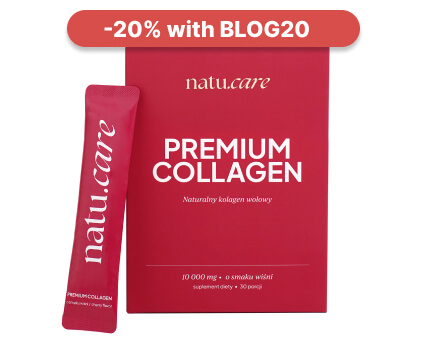
- Collagen content: 10,000 mg of hydrolyzed bovine collagen
- Additional active ingredients: vitamin C, low molecular weight hyaluronic acid, glucosamine, chondroitin, extract of Indian frankincense resin (boswellia serrata)
- Form: powder sachets for drinking
- Serving: 1 sachet per day
- Lasts for: 30 days
Product description
One of the strongest collagens on the market, providing as much as 10,000 mg per daily serving. This product can effectively support the condition of joints, skin, hair, and nails.
With this supplement, you will support your skeletal and joint system as well as your beauty, helping you visually halt the aging process and feel rejuvenated!
Pros and cons
Pros:
- The daily portion of collagen is very large – as much as 10,000 mg.
- Proven collagen formula – COLLinstant, whose effectiveness has been confirmed in clinical studies.
- Effective dose of hyaluronic acid, which additionally moisturizes the skin and positively affects joint health.
- Vitamin C supports the body's natural collagen production.
- Glucosamine is a fundamental building block of compounds found in joint cartilage and a component of collagen that gives elasticity to connective tissue in tendons.
- Chondroitin is a natural component found in the human body, mainly in cartilage. This large molecule (mucopolysaccharide) has the ability to absorb water, which helps maintain the elasticity and resilience of cartilage.
- Frankincense resin extract supports blood circulation and joint mobility and reduces their stiffness. It may help alleviate inflammatory conditions.
- The composition has been tested by the independent and accredited J.S. Hamilton laboratory.
Cons:
- None.
Additional information
Users praise Natu.Care Collagen Premium for the easy dissolving of the powder.
Premium Sodium Butyrate
Product description
Premium Sodium Butyrate is a natural support for your digestive system. With a high dose of butyric acid (940 mg), it supports the regeneration of the intestinal mucosa, improving gut health and function, and aids in the absorption of nutrients. By taking care of your intestines, you're taking care of the health of your entire body.
Studies involving people suffering from irritable bowel syndrome confirm that sodium butyrate is ideal for supporting issues related to bacterial flora imbalances (for example, after antibiotic therapy), constipation and diarrhea, inflammation of the intestinal mucosa, or a diet low in fiber.
Premium Sodium Butyrate capsules are made using the innovative DRcaps® technology. This guarantees that the active ingredients in the product are protected from the destructive effects of stomach acids and digestive enzymes. As a result, we can be sure that the beneficial ingredients are released in the small intestine and are fully absorbed by our body.
Premium Sodium Butyrate from Natu Care is 100% tested, and its composition contains only the highest quality raw materials.
Pros and cons
Pros:
- Supports digestive system function
- Helpful for various gastrointestinal conditions, including IBS
- High dose of butyric acid in each capsule
- Eco-friendly, clean, and tested composition
- Free from added sugar, gluten, GMOs, and lactose
- Innovative capsule technology - DRcaps
Cons:
- None
Additional Information
Take 3 capsules daily at any time of the day, preferably with a meal. Swallow the capsules whole with water.
Premium Sodium Butyrate is intended for adults.
The product should be used under medical supervision.
User review
I've been using the product for 2 weeks. My stomach feels lighter, and my digestion has improved. I recommend it.
Natu.Care Premium Magnesium + Vitamin B6
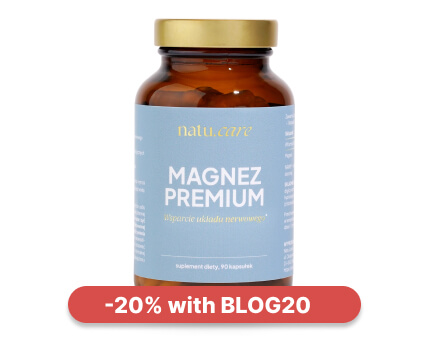
- Magnesium content per day: 305 mg
- Additional active ingredients: Vitamin B6 (2.1 mg)
- Form: capsules
- Serving size: 3 capsules per day
- Sufficient for: 30 days
Product description
The Premium Magnesium + Vitamin B6 dietary supplement is a comprehensive product that combines three organic forms of magnesium (citrate, malate, and diglycinate) and vitamin B6 in highly absorbable forms.
Magnesium is an essential mineral without which our bodies cannot function properly. It supports the immune, nervous, and muscular systems, maintains electrolyte balance, and is involved in cell division and the regulation of mental functions.
Research shows that magnesium supplementation is even more effective when accompanied by vitamin B6, which is included in our product. Vitamin B6 is responsible for the proper functioning of the nervous and immune systems, as well as the proper functioning of the heart.
If you want to safely get rid of feelings of fatigue, concentration problems, hair loss, muscle cramps, trembling, or irritability, reach for Premium Magnesium from Natu.Care, tested by the independent, certified laboratory J.S. Hamilton Poland.
Pros and cons
Pros
- Supports the proper functioning of the nervous and immune systems.
- Reduces feelings of fatigue and tiredness.
- Maintains proper psychological functions.
- The purity of the ingredients (free from anti-caking agents, artificial fillers, and additives such as titanium dioxide, microcrystalline cellulose, talc, magnesium stearate, and silicon dioxide) has been confirmed by laboratory tests.
- High absorption of ingredients.
- Soft capsules that are easy to swallow.
- Suitable for vegetarians and vegans.
Cons
- None.
Additional information
Take with a meal, 3 capsules per day.
The capsules should be taken with at least 250 ml of water.
If you have trouble sleeping, it is advisable to take 1 capsule in the morning and 2 capsules in the evening, no later than 4 hours before bedtime.
Avoid combining with products high in calcium (milk, yogurt, cheese), as this may negatively affect magnesium absorption.
Pregnant and breastfeeding women should consult a doctor before starting supplementation.
User review
I’m very impressed with the speed of delivery. The product itself is of high quality and absorbs well. After two weeks of supplementation, I’ve noticed a significant improvement in muscle recovery, especially during periods of intense training. I highly recommend it!
Product description
The dietary supplement contains omega-3ᵀᴳ, or omega-3 acids in the form of trójglyceridesów. Scientific studies suggest that this form of fatty acidsós up to 2 times better absorbed than the estersós present in many dietary supplements on the market. This means that you are assured of their effectiveness and of supplying yourself with valuable omega acids.
Fatty acids omega-3 are derived from wild anchovy oil. It is a rich source of healthy fats that are essential for the health of the cardiovascular, immune and nervous systems, as well as the proper function of vision, joints muscles.
Scientific research suggests that wild anchovies are a good source of healthy fats.
Scientific research also suggests that an adequate intake of omega-3 fatty acidsós protects against and supports the treatment of depression and anxiety disorders. In addition, omega-3s influence the hydration and appearance of the skinóry and support healthy sleep.
.
The formula contains a total of 750 mg of EPA+DHA acidsós, which is three times higher than the recommended minimum of 250 mg for the Polish population. Omega-3 TG Premium has studies indicating that its TOTOX is 9, which is a very good result.
Supplementation of omega-3 fatty acidsóis recommended for anyone who does not eat 1–2 portions (approximately 300 g) of oily fish per week. Children during growth, seniors, physically active people, vegans and vegetarians, as well as patients undergoing cardiovascular treatment and prevention of heart disease also have an increased need.
Pros and cons
The dietary supplement contains omega-3ᵀᴳ, or omega-3 acids in the form of trójglyceridesów. Scientific studies suggest that this form of fatty acidsós up to 2 times better absorbed than the estersós present in many dietary supplements on the market. This means that you are assured of their effectiveness and of supplying yourself with valuable omega acids.
Fatty acids omega-3 are derived from wild anchovy oil. It is a rich source of healthy fats that are essential for the health of the cardiovascular, immune and nervous systems, as well as the proper function of vision, joints muscles.
Scientific research suggests that wild anchovies are a good source of healthy fats.
Scientific research also suggests that an adequate intake of omega-3 fatty acidsós protects against and supports the treatment of depression and anxiety disorders. In addition, omega-3s influence the hydration and appearance of the skinóry and support healthy sleep.
.
The formula contains a total of 750 mg of EPA+DHA acidsós, which is three times higher than the recommended minimum of 250 mg for the Polish population. Omega-3 TG Premium has studies indicating that its TOTOX is 9, which is a very good result.
Supplementation of omega-3 fatty acidsóis recommended for anyone who does not eat 1–2 portions (approximately 300 g) of oily fish per week. Children during growth, seniors, physically active people, vegans and vegetarians, as well as patients undergoing cardiovascular treatment and prevention of heart disease also have an increased need.
Additional information
The dietary supplement contains omega-3ᵀᴳ, or omega-3 acids in the form of trójglyceridesów. Scientific studies suggest that this form of fatty acidsós up to 2 times better absorbed than the estersós present in many dietary supplements on the market. This means that you are assured of their effectiveness and of supplying yourself with valuable omega acids.
Fatty acids omega-3 are derived from wild anchovy oil. It is a rich source of healthy fats that are essential for the health of the cardiovascular, immune and nervous systems, as well as the proper function of vision, joints muscles.
Scientific research suggests that wild anchovies are a good source of healthy fats.
Scientific research also suggests that an adequate intake of omega-3 fatty acidsós protects against and supports the treatment of depression and anxiety disorders. In addition, omega-3s influence the hydration and appearance of the skinóry and support healthy sleep.
.
The formula contains a total of 750 mg of EPA+DHA acidsós, which is three times higher than the recommended minimum of 250 mg for the Polish population. Omega-3 TG Premium has studies indicating that its TOTOX is 9, which is a very good result.
Supplementation of omega-3 fatty acidsóis recommended for anyone who does not eat 1–2 portions (approximately 300 g) of oily fish per week. Children during growth, seniors, physically active people, vegans and vegetarians, as well as patients undergoing cardiovascular treatment and prevention of heart disease also have an increased need.
Expert opinion
The dietary supplement contains omega-3ᵀᴳ, or omega-3 acids in the form of trójglyceridesów. Scientific studies suggest that this form of fatty acidsós up to 2 times better absorbed than the estersós present in many dietary supplements on the market. This means that you are assured of their effectiveness and of supplying yourself with valuable omega acids.
Fatty acids omega-3 are derived from wild anchovy oil. It is a rich source of healthy fats that are essential for the health of the cardiovascular, immune and nervous systems, as well as the proper function of vision, joints muscles.
Scientific research suggests that wild anchovies are a good source of healthy fats.
Scientific research also suggests that an adequate intake of omega-3 fatty acidsós protects against and supports the treatment of depression and anxiety disorders. In addition, omega-3s influence the hydration and appearance of the skinóry and support healthy sleep.
.
The formula contains a total of 750 mg of EPA+DHA acidsós, which is three times higher than the recommended minimum of 250 mg for the Polish population. Omega-3 TG Premium has studies indicating that its TOTOX is 9, which is a very good result.
Supplementation of omega-3 fatty acidsóis recommended for anyone who does not eat 1–2 portions (approximately 300 g) of oily fish per week. Children during growth, seniors, physically active people, vegans and vegetarians, as well as patients undergoing cardiovascular treatment and prevention of heart disease also have an increased need.
Natu.Care Vitamin D 2000 UI
Product description
Vitamin D plays a crucial role in our health and well-being. It affects calcium and phosphate metabolism, which translates to healthy bones and teeth. It also helps regulate the immune system, and studies indicate its influence on the functioning of the nervous system.
Vitamin D, although called a “vitamin,” is actually a prohormone that our body produces on its own, primarily under the influence of sunlight. Unfortunately, our modern lifestyle contributes to deficiencies of this essential vitamin. Working in enclosed office buildings, using (necessary!) SPF creams, and covering the body with clothing all make it very difficult, if not impossible, to obtain adequate levels of vitamin D from sunlight. This is why appropriate, year-round supplementation is so crucial.
Vitamin D from Natu.Care is a well-tested vitamin D3 suspended in safflower oil, a plant known for its numerous health benefits. The convenient, easy-to-swallow capsule will make supplementation a part of your daily, healthy routine, improving your overall well-being.
Pros and cons
Pros:
- Ensures proper functioning of the immune system
- Supports the maintenance of healthy bones and teeth
- Maintains proper heart, kidney, and muscle function
- Tested by an independent, certified laboratory
- Convenient and easy-to-swallow capsule
- Clean composition - free from added sugar, gluten, GMOs, lactose, and without preservatives or colorants
Cons:
- None.
Additional Information
Pregnant women and breastfeeding mothers should consult a doctor before using the product. This dietary supplement is intended for a healthy adult population up to the age of 75.
Collagen Booster - Glow Stories

- Active ingredients: bamboo shoot extract, Quatrefolic®, L-Methionine, L-cysteine, vitamin E, vitamin A, niacin (vitamin B3), vitamin B6, vitamin B2 (riboflavin), biotin, zinc, copper
- .
- Form: capsules
- .
- Dose: 1 capsule per day
- .
- Sufficient for: 60 days
- .
Product description
A dietary supplement containing vitamins, minerals and plant extracts thatósupport the skinóhand, hair and nails. The product is especially distinguished by the form of folate – it is Quatrefolic, whichós absorbed very well and is natural.
In addition to valuable vitamins and minerals, such as vitamin A, E, B3, B2 and biotin, the formula contains bamboo shoot extract, whichóry further enhances your beauty.
Pros and cons
A dietary supplement containing vitamins, minerals and plant extracts thatósupport the skinóhand, hair and nails. The product is especially distinguished by the form of folate – it is Quatrefolic, whichós absorbed very well and is natural.
In addition to valuable vitamins and minerals, such as vitamin A, E, B3, B2 and biotin, the formula contains bamboo shoot extract, whichóry further enhances your beauty.
Additional information
A dietary supplement containing vitamins, minerals and plant extracts thatósupport the skinóhand, hair and nails. The product is especially distinguished by the form of folate – it is Quatrefolic, whichós absorbed very well and is natural.
In addition to valuable vitamins and minerals, such as vitamin A, E, B3, B2 and biotin, the formula contains bamboo shoot extract, whichóry further enhances your beauty.
What is the daily requirement for iron?
.
The daily requirement for iron depends on age and gender. What's more, it also changes during pregnancy and lactation, so you should scrupulously watch your standards. What are the recommendations for the Polish population?
.
|
Age and gender . |
Daily iron requirementsand |
|
|
Infants 0-6 months . |
0.3 mg |
|
|
Infants 7-11 months . |
11 mg
|
|
|
Children 1-3 years |
7 mg |
|
|
Children 4-9 years |
10 mg |
|
|
Boys 10-12 years |
10 mg |
|
|
Girls 10-12 years |
||
| . |
10 (15) mg* |
|
|
Boys 13-18 years . |
12 mg |
|
|
Girls 13-18 years |
||
| . |
15 mg |
|
|
Males > 19 years |
10 mg |
|
|
Females 19-50 years |
18 mg |
|
|
Females > 50 years |
10 mg |
* Before or after the onset of menstruation
.
Pregnant women should take 27 mg of iron daily regardless of age. Breastfeeding mothers, on the other hand, require 10 mg regardless of age.
Maximum safe daily dose of iron
.
While an overdose of iron from the diet is very unlikely (except in cases where you genetically assimilate too much of the ingredient), supplementation can lead to this. Therefore, along with the recommended values, it is also worth knowing these upper limits.
|
Age |
Upper limit of iron non-toxicityand |
|
0-13 years |
40 mg |
|
> 14 years |
45 mg |
Symptoms of iron deficiency
.
The symptoms of iron deficiency may be harmless at first, but will steadily worsen over time. What symptoms may suggest this conditionand?
- Fatigue and weakness. These are often the first signs of iron deficiency. The ingredient is essential for the production of haemoglobin, which supplies oxygen to all cells in the body. If cells do not have access to enough oxygen, you may experience general weakness and fatigue.
- Deficiency of the skin. It is haemoglobin that provides the blood with its red colour, so low levels of this protein -resulting from iron deficiency - can make the skin fade.
- Pnea. Iron deficiency can lead to shortness of breath, as the body tries to compensate for the lack of oxygen in the cells by speeding up breathing.
- Muscle weakness. Lack of iron in the diet can also result in muscle weakness and an inability to maintain standard physical activity.
- Deficiencies in concentration. If your brain does not get enough oxygen, you may experience problems with concentration and memory.
- Hair loss. Iron is involved in many important physiological processes in the hair follicle, and a deficiency can disrupt hair strand synthesis and cause hair loss.
Who is at particular risk of iron deficiency?
.
Iron deficiency is a common health problem that can affect people of all ages and lifestyles. However, there are certain groups that are particularly vulnerable to this condition. Which ones?
Senior citizens are also at risk of iron deficiency.
|
Risk group . |
Why is at risk of iron deficiency?and |
||
|
Pregnant women . |
Because of the increased need for iron due to the progressive development of the foetus and the body's preparation for childbirth, pregnant women are at risk of iron deficiency. |
Pregnant women are at risk of iron deficiency. |
|
|
People on a vegan or vegetarian diet |
. |
Iron of plant origin is less well absorbed by the body, which is associated with an increased likelihood of iron deficiency in the body in people who do not eat meat. |
People who do not eat meat. |
|
Menstruating women . |
Regular blood loss during menstruation can lead to iron deficiency, especially if a woman's diet is deficient in this component. |
||
|
Persons with gastrointestinal diseases |
Diseases such as Crohn's disease or celiac disease can be managed. Disorders such as Crohn's disease and coeliac disease can lead to impaired iron absorption in the gastrointestinal tract. |
Disorders such as Crohn's disease and coeliac disease can lead to impaired iron absorption in the gastrointestinal tract. |
|
|
Athletes |
Intensive physical activity may increase the need for this mineral due to faster metabolism and increased iron excretion in sweat and urine. |
Intensive exercise may increase the need for this mineral due to faster metabolism and increased iron excretion in sweat and urine. |
|
|
Seniors |
Because of age-related metabolic changes, seniors are also a risk group for iron deficiency. Difficulties in absorbing this nutrient may also result from the use of certain medications, which is often the case in the elderly. |
It is worth paying attention to the hygiene of your food intake - too little caloric supply, drinking coffee and tea with meals or not eating vegetables and fruits - are additional factors affecting iron absorption..
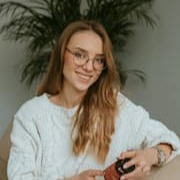 .
.
Julia SkrajdaDietitian
.See also:
.
- Vitamin B12 - properties
- Vitamin D3 - effects .
- Vitamin A - functions in the body .
- Vitamin B1 - properties .
- Vitamin E - effects .
- Pantothenic acid - what it is .
- Folic acid (vitamin B9) - properties .
- Vitamin B3 - effects
- Vitamin K - where it occurs
- Vitamin B6 - what it is .
- Vitamin C - properties .
Summary
.
- Products rich in iron include meat, fish, legumes, seeds, leafy vegetables and offal.
- Iron is present in all foods.
- Iron is found in heme form (in animal products) and non-heme form (in plant products).
- Iron deficiency is a common problem.
- Iron deficiency in children and infants is a common problem, which can be combated by introducing iron-rich foods into the diet.
- Pregnant women should consume good quality sources of iron, such as red meat, poultry, offal, legumes, leafy vegetables, mussels or tofu.
- Daily iron requirements depend on age and gender, and are further increased during pregnancy. .
- Iron overdose from diet is unlikely, but inappropriate supplementation can lead to this. .
- Symptoms of iron deficiency include fatigue, pale skin, shortness of breath, muscle weakness and concentration problems.
FAQ
Can a vegan or vegetarian diet provide adequate iron?
.Yes, people following a vegan or vegetarian diet can provide the body with adequate amounts of iron by consuming plant foods rich in this mineral, such as lentils, legumes, pumpkin seeds and spinach.
It is important to remember, however, that iron from plants (so-called non-haem iron) is less well absorbed by the body. However, you can compensate for this by eating foods rich in vitamin C, which increases the absorption of this form of iron.
Can drinking coffee or tea affect iron absorption?
.Yes, drinking coffee and tea can adversely affect the bioavailability of iron. This has to do with the polyphenol content of these drinks, which inhibits the body's absorption of iron. It is therefore recommended to avoid drinking coffee or tea immediately before, during or after a meal so as not to interfere with iron absorption. Maintain an interval of at least two hours.
What are the effects of excessive iron intake?
.Overconsumption of iron in diet is rare, but can lead to toxicity that manifests as diarrhoea, nausea, vomiting, weakness or abdominal pain. Chronic iron excess, on the other hand, can result in organ damage, especially to the liver and serious diseases like diabetes.
Overconsumption of iron from dietary supplements can cause very dark coloured stools and constipation.
Do athletes have a greater need for iron?
.Athletes, especially those who do endurance training (e.g. running, triathlon, cycling), may have an increased need for iron because exercise speeds up the metabolic rate, increases its excretion and thus the need for iron increases.
Do athletes have an increased need for iron?
Does drinking alcohol affect body iron levels?
.Drinking alcohol can negatively affect the levels of iron in the body. Alcohol increases the bioavailability of this mineral, so regular consumption of large amounts of alcoholic beverages, can lead to an excess of it. This, in turn, is a health risk, especially to the liver.
Can I use iron supplements without consulting my doctor?
.Although iron deficiency is a common problem, it is always a good idea to consult your doctor before starting supplements. Excess iron can be detrimental to health, and some people, such as those with a genetic tendency to accumulate too much of the mineral, may be at particular risk.
What tests can confirm iron deficiency?
.The basic tests that can diagnose iron deficiency are a blood iron and ferritin test and haemoglobin levels. If the results are below normal, this may suggest iron deficiency, but you should always consult your doctor.
.
Sources
.See all
.Camaschella, C. (2019). Iron deficiency. Blood, 133(1), 30–39. https://doi.org/10.1182/blood-2018-05-815944
Cappellini, M. D., Musallam, K. M., & Taher, A. T. (2020). Iron deficiency anaemia revisited. Journal of Internal Medicine, 287(2), 153-170. https://doi.org/10.1111/joim.13004
Comparative Effects Between Oral Lactoferrin and Ferrous Sulfate Supplementation on Iron-Deficiency Anemia: A Comprehensive Review and Meta-Analysis of Clinical Trials-PMC. Retrieved 13 December 2023, from https://www.ncbi.nlm.nih.gov/pmc/articles/PMC8838920/
DeLoughery, T. G. (2017). Iron Deficiency Anemia. The Medical Clinics of North America, 101(2), 319-332. https://doi.org/10.1016/j.mcna.2016.09.004
FoodData Central. (n.d.-a). Retrieved December 13, 2023, from https://fdc.nal.usda.gov/fdc-app.html#/food-details/170273/nutrients
FoodData Central. (n.d.-b). Retrieved December 13, 2023, from https://fdc.nal.usda.gov/fdc-app.html#/food-details/172475/nutrients
FoodData Central. (n.d.-c). Retrieved December 13, 2023, from https://fdc.nal.usda.gov/fdc-app.html#/food-details/169967/nutrients
FoodData Central. (n.d.-d). Retrieved December 13, 2023, from https://fdc.nal.usda.gov/fdc-app.html#/food-details/171091/nutrients
FoodData Central. (n.d.-e). Retrieved December 13, 2023, from https://fdc.nal.usda.gov/fdc-app.html#/food-details/168917/nutrients
FoodData Central. (n.d.-f). Retrieved December 13, 2023, from https://fdc.nal.usda.gov/fdc-app.html#/food-details/170556/nutrients
FoodData Central. (n.d.-g). Retrieved December 13, 2023, from https://fdc.nal.usda.gov/fdc-app.html#/food-details/174035/nutrients
FoodData Central. (n.d.-h). Retrieved December 13, 2023, from https://fdc.nal.usda.gov/fdc-app.html#/food-details/172421/nutrients
FoodData Central. (n.d.-i). Retrieved December 13, 2023, from https://fdc.nal.usda.gov/fdc-app.html#/food-details/168626/nutrients
FoodData Central. (n.d.-j). Retrieved December 13, 2023, from https://fdc.nal.usda.gov/fdc-app.html#/food-details/168462/nutrients
FoodData Central. (n.d.-k). Retrieved December 13, 2023, from https://fdc.nal.usda.gov/fdc-app.html#/food-details/171975/nutrients
FoodData Central. (n.d.-l). Retrieved December 13, 2023, from https://fdc.nal.usda.gov/fdc-app.html#/food-details/174035/nutrients
FoodData Central. (n.d.-m). Retrieved December 13, 2023, from https://fdc.nal.usda.gov/fdc-app.html#/food-details/171975/nutrients
Leung, A. K. C., Lam, J., Wong, A. H. C., Hon, K. L., & Li, X. (2023). Iron deficiency anaemia: An updated review. Current Pediatric Reviews. https://doi.org/10.2174/1573396320666230727102042
.Moeinvaziri, M., Mansoori, P., Holakooee, K., Safaee Naraghi, Z., & Abbasi, A. (2009). Iron status in diffuse telogen hair loss among women. Acta Dermatovenerologica Croatica: ADC, 17(4), 279-284.
.Office of Dietary Supplements-Iron. (n.d.). Retrieved December 13, 2023, from https://ods.od.nih.gov/factsheets/Iron-HealthProfessional/
Pasricha, S.-R., Tye-Din, J., Muckenthaler, M. U., & Swinkels, D. W. (2021a). Iron deficiency. Lancet (London, England), 397(10270), 233–248. https://doi.org/10.1016/S0140-6736(20)32594-0
Pasricha, S.-R., Tye-Din, J., Muckenthaler, M. U., & Swinkels, D. W. (2021b). Iron deficiency. Lancet (London, England), 397(10270), 233–248. https://doi.org/10.1016/S0140-6736(20)32594-0
Piskin, E., Cianciosi, D., Gulec, S., Tomas, M., & Capanoglu, E. (2022). Iron Absorption: Factors, Limitations, and Improvement Methods. ACS Omega, 7(24), 20441-20456. https://doi.org/10.1021/acsomega.2c01833
Rosa, L., Cutone, A., Lepanto, M. S., Paesano, R., & Valenti, P. (2017). Lactoferrin: A Natural Glycoprotein Involved in Iron and Inflammatory Homeostasis. International Journal of Molecular Sciences, 18(9), https://doi.org/10.3390/ijms18091985
Warner, M. J., & Kamran, M. T. (2023a). Iron Deficiency Anemia. In StatPearls. StatPearls Publishing. http://www.ncbi.nlm.nih.gov/books/NBK448065/
Warner, M. J., & Kamran, M. T. (2023b). Iron Deficiency Anemia. In StatPearls. StatPearls Publishing. http://www.ncbi.nlm.nih.gov/books/NBK448065/
..
Editorials
Meet the team


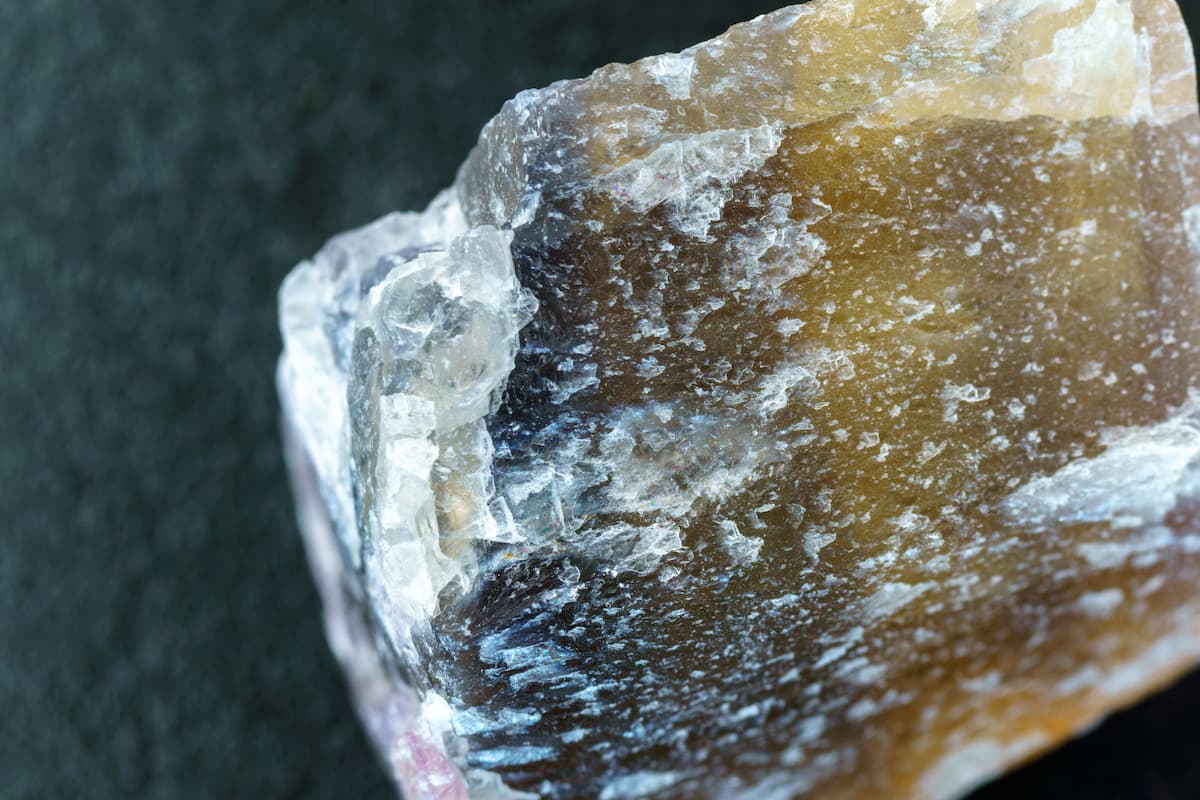
Fluoride is an essential mineral for the proper functioning of the body. How does it work and is it harmful? Check!
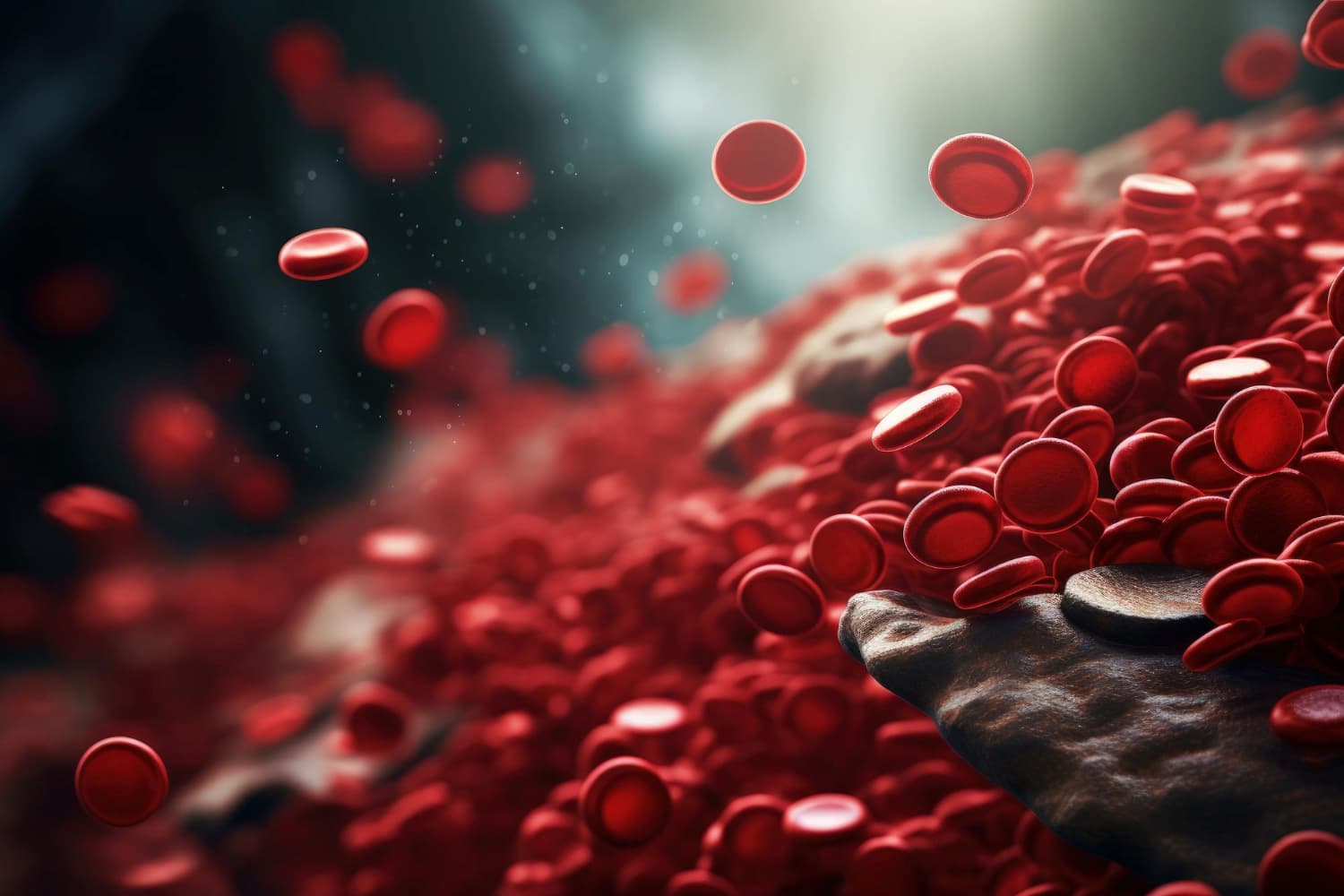
Iron deficiency is a dangerous condition leading to serious neurological and skin symptoms.

Phosphorus is a mineral element that supports bone health, nervous system function and also energy metabolism.



